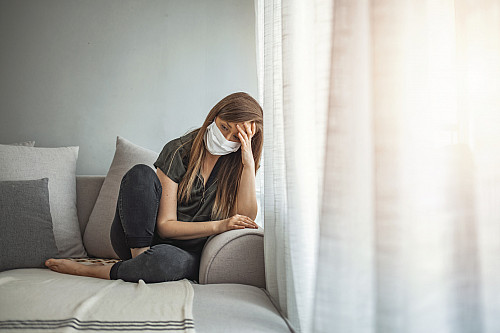What if someone in my household has COVID-19?
By Amanda Roach
September 17, 2021

You’re feeling fine, but someone in your household has symptoms of COVID-19 or just tested positive for the virus. Now what? You want to do the right thing to stop the spread of the virus, but you don’t want to unnecessarily disrupt your household’s normal routine.
Follow these steps to keep yourself and others healthy and safe:
Isolate symptoms
The absolute first step is for the person who is having symptoms to isolate. Ideally, this person will stay in one room that can be closed off from the rest of the house and have a bathroom to themselves. If the person has to be around others in the household, they should wear a mask and stay distanced.
Confirm the symptoms are COVID-19-related
The person with symptoms should get a symptomatic COVID-19 test as soon as possible.
If the individual is an IU faculty, staff or student, they should start with IU’s symptom checker. Once the person identifies their symptoms, they’ll receive an email to their IU email address with a link to schedule a symptomatic test.
If the person with symptoms is not affiliated with IU, testing locations are available through the Indiana Department of Health, or at local retail pharmacies or medical providers.
Being a close contact
If it’s confirmed that the symptomatic person in your household does have COVID-19, in most circumstances, the other members of the household will be considered close contacts. You’ll need to let IU know that you’re a close contact if the positive individual is not an IU student, faculty or staff.
- If you’re fully vaccinated (two doses of Pfizer or Moderna or one dose of Johnson & Johnson with, plus two weeks) with or without a booster:
- You do not need to quarantine as long as you are symptom-free.
- Wear a mask for the 10 days following your exposure when around others.
- Get tested for COVID-19 five days after exposure even if you do not have any symptoms.
- Cooperate with IU contact tracers to help stop the spread of the virus.
- Participate in daily COVID-19 symptom checks.
- If you’re not fully vaccinated:
- Quarantine for five days since you were last exposed to the person who tested positive. You cannot test out of quarantine.
- You should not leave your home for errands, picking up food, going to campus, etc.
- Following the five-day quarantine, wear a mask when around others for five additional days (days 6 to 10 following exposure).
- Get tested for COVID-19 five days after exposure even if you do not have any symptoms.
- Cooperate with IU contact tracers to help stop the spread of the virus.
- Participate in daily COVID-19 symptom checks.
Monitor symptoms
IU’s team of contact tracers reaches out to all faculty, staff and students who are identified as close contacts. In addition to providing information and instructions about what to do as a close contact, they’ll also enroll you in daily symptom monitoring. Whether you are vaccinated or not, you’ll receive daily text messages asking if you have any symptoms and checking on your health.
Getting back to normal
The person who tested positive will stay in isolation for five days, or until symptoms improve and they have been fever-free without medication for at least 24 hours. As long as fully vaccinated close contacts do not develop symptoms and their test is negative, they can return to their usual routine after receiving the negative test result. Unvaccinated close contacts can get back to normal activities after the five-day quarantine, as long as they do not have any symptoms.
The bottom line
If you’re having any symptoms, get tested. Stay at home until your symptoms go away, even if your test is negative, so you don’t spread other viruses. Until you’re 14 days from exposure, anyone in your household should assume they’re a close contact and monitor symptoms. And, if you’re not yet vaccinated, you can get vaccinated at any time.
Amanda Roach is a senior communications consultant in the Office of the Vice President for Communications and Marketing.